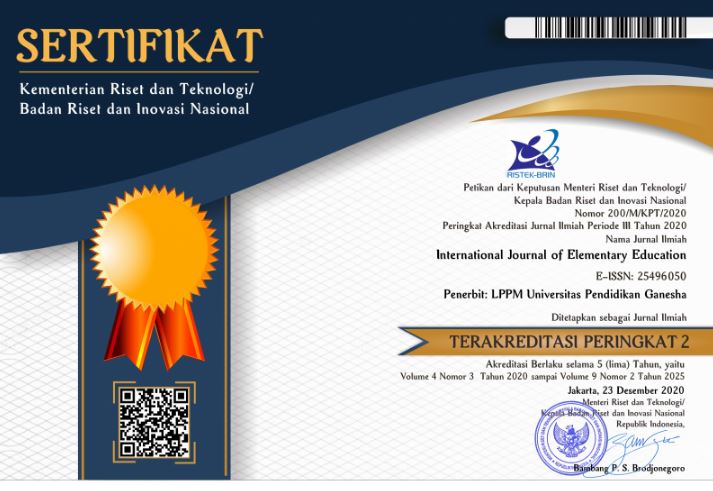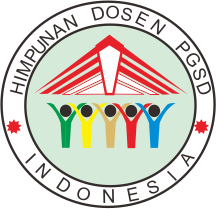Assistive Technology in Mathematics Education: Investigating the Effectiveness of Math Manipulatives for Students with Disabilities
DOI:
https://doi.org/10.23887/ijee.v8i3.85378Keywords:
Math-Manipulatives, Assistive Technology, Mathematics Learning, Students with Disabilities, Inclusive EducationAbstract
Mathematics education for students with disabilities often faces various challenges, such as difficulties in understanding abstract concepts and limitations in using adaptive media. This study aims to investigate the utilization of math manipulatives as assistive technology to support more inclusive and interactive mathematics learning. Employing a qualitative approach with an exploratory design, data were collected through focus group discussions (FGDs) and in-depth interviews involving teachers and students as primary respondents. Thematic analysis was used to identify patterns in the application of math manipulatives during the learning process. The findings reveal that math manipulatives, such as number boards, numeric cards, and other visual tools, significantly enhance students' comprehension of mathematical concepts concretely. Furthermore, the use of math manipulatives fosters students' learning motivation and active participation, particularly in group work. Additionally, these tools assist teachers in designing lessons that are more adaptive to students’ needs. The study concludes that math manipulatives as assistive technology holds substantial potential to support mathematics education for students with disabilities, addressing both cognitive and affective aspects. The latest information in this research provides an important contribution to the development of science in the field of inclusive education and educational technology.
References
Anditiasari, N. (2020). Analisis kesulitan belajar abk (Tuna Rungu) dalam menyelesaikan soal cerita matematika. Mathline: Jurnal Matematika Dan Pendidikan Matematika, 5(2), 183–194. https://doi.org/10.31943/mathline.v5i2.162.
Azzahra, A. H., Safitri, D., & Sujarwo, S. (2024). Peran Teknologi Non-Visual Desktop Access (NVDA) Untuk Siswa Tunanetra dalam Proses Pembelajaran. Jurnal Teknologi Pendidikan, 1(4). https://doi.org/10.47134/jtp.v1i4.606.
Bouck, E. C., Park, J., & Stenzel, K. (2020). Virtual manipulatives as assistive technology to support students with disabilities with mathematics. Preventing School Failure: Alternative Education for Children and Youth, 64(4), 281–289. https://doi.org/10.1080/1045988X.2020.1762157.
Daroni, G. A., Gunarhadi, & Legowo, E. (2018). Assistive technology in mathematics learning for visually impaired students. Tadris: Jurnal Keguruan Dan Ilmu Tarbiyah, 3(1), 1–9. https://doi.org/10.24042/tadris.v3i1.2406.
Desmond, D., Layton, N., Bentley, J., Boot, F. H., Borg, J., Dhungana, B. M., & Scherer, M. J. (2018). Assistive technology and people: a position paper from the first global research, innovation and education on assistive technology (GREAT) summit. Disability and Rehabilitation: Assistive Technology, 13(4), 437–444. https://doi.org/10.1080/17483107.2018.1471169.
Fricticarani, A., Hayati, Am., R, R., Hoirunisa, I., & Rosdalina, G. M. (2023). Strategi pendidikan untuk sukses di era teknologi 5.0. Jurnal Inovasi Pendidikan Dan Teknologi Informasi (JIPTI), 4(1), 56–68. https://doi.org/10.52060/pti.v4i1.1173.
Hasyim, M., Umam, A. K., Zainab, S., & Wukandari, D. (2019). Peningkatan Keterampilan Guru SDLB Melalui Pelatihan Media Pembelajaran Matematika Manipulatif. J-ADIMAS (Jurnal Pengabdian Kepada Masyarakat), 7(1), 41–45. https://doi.org/10.29100/j-adimas.v7i1.1157.
Isti’ana, A. (2024). Integrasi Teknologi dalam Pembelajaran Pendidikan Islam. Indonesian Research Journal on Education, 4(1). https://doi.org/10.31004/irje.v4i1.493.
Kania, N. (2018). Alat Peraga untuk Memahami Konsep Pecahan. Jurnal THEOREMS (The Original Research of Mathematics), 2(2). https://doi.org/10.31949/th.v2i2.699.
Lantz, J., & Miller, C. (2020). The Effectiveness of Manipulatives During 1:1 Mathematics Intervention. Aletheia—The Alpha Chi Journal of Undergraduate Scholarship, 5(1). Retrieved from https://alphachihonor.org/headquarters/files/Website Files/Aletheia/Volume 5 Issue 1 Spring 2020/Effectiveness-of-Manipulatives-During-Math-Intervention.pdf.
MacLachlan, M., Banes, D., Bell, D., Borg, J., Donnelly, B., Fembek, M., … Hooks, H. (2018). Assistive technology policy: a position paper from the first global research, innovation, and education on assistive technology (GREAT) summit. Disability and Rehabilitation: Assistive Technology, 13(5), 454–466. https://doi.org/0.1080/17483107.2018.1468496.
Manan, A. (2023). Pendidikan Islam dan Perkembangan Teknologi: Menggagas Harmoni dalam Era Digital. Scholastica Jurnal Pendidikan Dan Kebudayaan, 5(1). Retrieved from http://www.jurnal.stitnualhikmah.ac.id/index.php/scholastica/article/view/1865.
Martiasari, A., & Kelana, J. B. (2022). Peningkatan Pemahaman Konsep Matematika Menggunakan Model Pembelajaran Problem Based Learning Berbantuan Media Manipulatif Untuk Siswa Sekolah Dasar. Jurnal Profesi Pendidikan, 1(1), 1–10. https://doi.org/10.22460/jpp.v1i1.10356.
Mudjiyanto, B. (2018). Tipe penelitian eksploratif komunikasi. Jurnal Studi Komunikasi Dan Media, 22(1). https://doi.org/10.31445/jskm.2018.220105.
Murni, F., Marjo, H. K., & Wahyuningrum, E. (2022). Pengaruh Penggunaan Media Manipulatif pada Pembelajaran Matematika dan Kepercayaan Diri terhadap Hasil Belajar Siswa Kelas III Sekolah Dasar. ELSE (Elementary School Education Journal) Jurnal Pendidikan Dan Pembelajaran Sekolah Dasar, 6(2), 438. https://doi.org/10.30651/else.v6i2.13434.
Ni’mah, L., & Sugiman, S. (2020). The growth of mathematical imagination of students of a deaf school when learning using Problem-Based Learning assisted by manipulative teaching aids. Unnes Journal of Mathematics Education, 9(2), 102–107. https://doi.org/10.15294/ujme.v9i2.40540.
Park, J., Bryant, D. P., & Shin., M. (2022). Effects of interventions using virtual manipulatives for students with learning disabilities: A synthesis of single-case research. Journal of Learning Disabilities, 55(4), 325–337. https://doi.org/10.1177/00222194211006336.
Peltier, C., Morin, K. L., Bouck, E. C., Lingo, M. E., Pulos, J. M., Scheffler, F. A., … Deardorff, M. E. (2019). A Meta-Analysis of Single-Case Research Using Mathematics Manipulatives With Students At Risk or Identified With a Disability. The Journal of Special Education, 54(1). https://doi.org/10.1177/0022466919844516.
Rahayu, R., Iskandar, S., & Abidin, Y. (2022). Inovasi Pembelajaran Abad 21 dan Penerapannya di Indonesia. Jurnal Basicedu, 6(2), 2099–2104. https://doi.org/10.31004/basicedu.v6i2.2082.
Rahmat, R., Asrori, M., & Hairida, H. (2023). Pemanfaatan Media Manipulatif dalam Pembelajaran Matematika untuk Meningkatkan Motivasi dan Hasil Belajar Siswa Kelas VI. AS-SABIQUN, 5(6), 1520–1537. https://doi.org/10.36088/assabiqun.v5i6.4020.
Ristanti, Y. (2016). Peningkatan motivasi dan keterampilan hitung pecahan desimal melalui media manipulatif pada pembelajaran tematik-integratif SD. Jurnal Riset Pendidikan Matematika, 3(1), 122–136. https://doi.org/10.21831/jrpm.v3i1.9686.
Rosita, T., Nurihsan, J., Juhanaini, J., & Sunardi, S. (2022). Assistive Technology for Dyslexia Students in Elementary School. JPI (Jurnal Pendidikan Indonesia), 11(2), 353–361. https://doi.org/10.23887/jpiundiksha.v11i2.36452.
Sakiinatullaila, N., K., F. D., Priyanto, M., Fajar, W., & Ibrahim, I. (2020). Penyebab Kesulitan Belajar Matematika Anak Berkebutuhan Khusus Tipe Slow Learner. Jurnal Pendidikan Matematika (Kudus), 3(2), 151–162. https://doi.org/10.21043/jmtk.v3i2.7471.
Septikasari, R., & Frasandy, R. N. (2018). Keterampilan 4C Abad 21 Dalam Pembelajaran Pendidikan Dasar. Tarbiyah Al-Awlad: Jurnal Kependidikan Islam Tingkat Dasar, 8(2), 107–117. https://doi.org/10.15548/alawlad.v8i2.1597.
Setiyani, S., Ferdianto, F., Tarmidzi, T., Santi, D. P. D., Jaufillaili, J., & Erawati, T. (2021). Pelatihan Pembuatan Alat Peraga Manipulatif Bernuansa Budaya Lokal di SD Negeri II Kedungjaya Kabupaten Cirebon. KUAT: Keuangan Umum Dan Akuntansi Terapan, 3(2), 107–114. https://doi.org/10.31092/kuat.v3i2.1431.
Siahaan, D. W., MS, E., Sagala, F., Togatorop, P., & Widiastuti, M. (2022). Penerapan Pembelajaran Kepada Anak Tunarungu Yang Terdapat Di Sekolah Slb Siborong-Borong. Jurnal Pendidikan Sosial Dan Humaniora, 1(4), 507–513. Retrieved from https://publisherqu.com/index.php/pediaqu/article/view/110.
Sidik, M. A., Wasino, W., Sarwi, S., Subali, B., & Widiarti, N. (2024). Analisis Trend Media Pembelajaran Matematika Jaring-Jaring Kubus dan Balok di Sekolah Dasar Periode 2020-2024. Pendas: Jurnal Ilmiah Pendidikan Dasar, 9(4), 342–352. https://doi.org/10.23969/jp.v9i04.20121.
Siregar, T., Sahala, M., Purba, N., Sinaga, E. C., & Siahaan, S. O. (2024). Analisis Kesulitan Belajar Siswa SD Negeri 167102 Rambutan dalam Mata Pelajaran Matematika. Jurnal Guru Kita, 8(2), 223–236. https://doi.org/10.24114/jgk.v8i2.53823.
Suryawan, I. P. P., Agustika, G. N. S., Sukmana, A. I. W. I. Y., Isumunuartha, G. R., & Sanjaya, I. P. A. (2021). Aktivasi media pembelajaran matematika manipulatif konkrit di SD Gugus V Kecamatan Kintamani-Bangli. Widya Laksana, 10(1), 100–110. https://doi.org/10.23887/jwl.v10i1.30266.
Tjandra, C. (2023). Effectiveness of Using Manipulatives in Mathematics Teaching in Inclusive Education Programs in an Elementary School. Dharmas Education Journal (DE_Journal), 4(1), 168–178. https://doi.org/10.56667/dejournal.v4i1.944.
Tracy, S. J. (2019). Qualitative Research Methods: Collecting Evidence, Crafting Analysis, Communicating Impact. Wiley.
Wondo, M. T. S., & Meke, K. D. P. (2021). Analisis pengaruh sikap percaya diri siswa dalam pembelajaran Matematika Menggunakan model PBL berbantuan bahan manipulatif. Jupika: Jurnal Pendidikan Matematika, 4(1). https://doi.org/10.37478/jupika.v4i1.894.
Yulia, S. A., Sripatmi, S., & Baidowi, B. (2021). Pengaruh Penggunaan Alat Peraga Benda Manipulatif Terhadap Hasil Belajar Matematika. Griya Journal of Mathematics Education and Application, 1(2). Retrieved from https://mathjournal.unram.ac.id/index.php/Griya/article/view/36.
Zen, L. F., Rachim, H. A., & Apsari, N. C. (2024). Penggunaan Teknologi Asistif: Peningkatan Kemandirian Penyandang Disabilitas Fisik. Share: Social Work Journal, 14(2), 135–147. https://doi.org/10.24198/share.v14i2.52420.
Downloads
Published
How to Cite
Issue
Section
License
Copyright (c) 2024 I Wayan Widiana, I Nyoman Jampel, I Gede Wahyu Suwela Antara

This work is licensed under a Creative Commons Attribution-ShareAlike 4.0 International License.
Authors who publish with the International Journal of Elementary Education agree to the following terms:
- Authors retain copyright and grant the journal the right of first publication with the work simultaneously licensed under a Creative Commons Attribution License (CC BY-SA 4.0) that allows others to share the work with an acknowledgment of the work's authorship and initial publication in this journal.
- Authors are able to enter into separate, additional contractual arrangements for the non-exclusive distribution of the journal's published version of the work (e.g., post it to an institutional repository or publish it in a book), with an acknowledgment of its initial publication in this journal.
- Authors are permitted and encouraged to post their work online (e.g., in institutional repositories or on their website) prior to and during the submission process, as it can lead to productive exchanges, as well as earlier and greater citation of published work. (See The Effect of Open Access)








